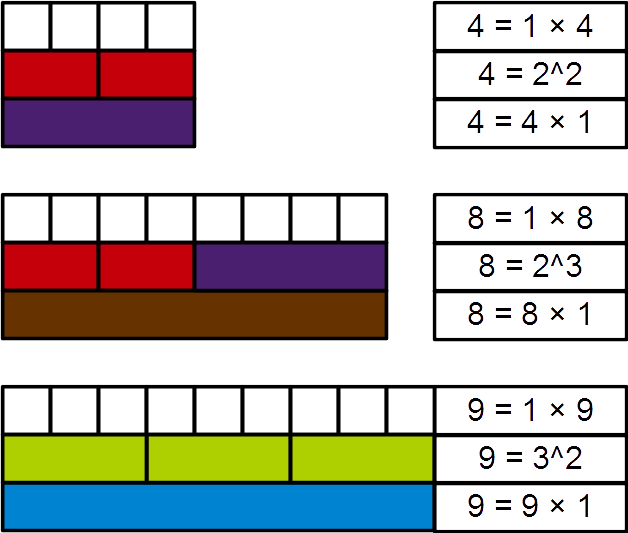Perfect Power on:
[Wikipedia]
[Google]
[Amazon]
 In
In
Lluís Bibiloni, Pelegrí Viader, and Jaume Paradís, On a Series of Goldbach and Euler, 2004 (Pdf)
{{Classes of natural numbers Number theory Integer sequences
 In
In mathematics
Mathematics is a field of study that discovers and organizes methods, Mathematical theory, theories and theorems that are developed and Mathematical proof, proved for the needs of empirical sciences and mathematics itself. There are many ar ...
, a perfect power is a natural number
In mathematics, the natural numbers are the numbers 0, 1, 2, 3, and so on, possibly excluding 0. Some start counting with 0, defining the natural numbers as the non-negative integers , while others start with 1, defining them as the positive in ...
that is a product of equal natural factors, or, in other words, an integer
An integer is the number zero (0), a positive natural number (1, 2, 3, ...), or the negation of a positive natural number (−1, −2, −3, ...). The negations or additive inverses of the positive natural numbers are referred to as negative in ...
that can be expressed as a square or a higher integer power of another integer greater than one. More formally, ''n'' is a perfect power if there exist natural number
In mathematics, the natural numbers are the numbers 0, 1, 2, 3, and so on, possibly excluding 0. Some start counting with 0, defining the natural numbers as the non-negative integers , while others start with 1, defining them as the positive in ...
s ''m'' > 1, and ''k'' > 1 such that ''mk'' = ''n''. In this case, ''n'' may be called a perfect ''k''th power. If ''k'' = 2 or ''k'' = 3, then ''n'' is called a perfect square or perfect cube, respectively. Sometimes 0 and 1 are also considered perfect powers (0''k'' = 0 for any ''k'' > 0, 1''k'' = 1 for any ''k'').
Examples and sums
Asequence
In mathematics, a sequence is an enumerated collection of objects in which repetitions are allowed and order matters. Like a set, it contains members (also called ''elements'', or ''terms''). The number of elements (possibly infinite) is cal ...
of perfect powers can be generated by iterating through the possible values for ''m'' and ''k''. The first few ascending perfect powers in numerical order (showing duplicate powers) are :
:
The sum of the reciprocals of the perfect powers (including duplicates such as 34 and 92, both of which equal 81) is 1:
:
which can be proved as follows:
:
The first perfect powers without duplicates are:
:(sometimes 0 and 1), 4, 8, 9, 16, 25, 27, 32, 36, 49, 64, 81, 100, 121, 125, 128, 144, 169, 196, 216, 225, 243, 256, 289, 324, 343, 361, 400, 441, 484, 512, 529, 576, 625, 676, 729, 784, 841, 900, 961, 1000, 1024, ...
The sum of the reciprocals of the perfect powers ''p'' without duplicates is:
:
where μ(''k'') is the Möbius function and ζ(''k'') is the Riemann zeta function.
According to Euler, Goldbach showed (in a now-lost letter) that the sum of over the set of perfect powers ''p'', excluding 1 and excluding duplicates, is 1:
:
This is sometimes known as the Goldbach–Euler theorem.
Detecting perfect powers
Detecting whether or not a given natural number ''n'' is a perfect power may be accomplished in many different ways, with varying levels ofcomplexity
Complexity characterizes the behavior of a system or model whose components interact in multiple ways and follow local rules, leading to non-linearity, randomness, collective dynamics, hierarchy, and emergence.
The term is generally used to c ...
. One of the simplest such methods is to consider all possible values for ''k'' across each of the divisors of ''n'', up to . So if the divisors of are then one of the values must be equal to ''n'' if ''n'' is indeed a perfect power.
This method can immediately be simplified by instead considering only prime values of ''k''. This is because if for a composite where ''p'' is prime, then this can simply be rewritten as . Because of this result, the minimal value of ''k'' must necessarily be prime.
If the full factorization of ''n'' is known, say where the are distinct primes, then ''n'' is a perfect power if and only if
In logic and related fields such as mathematics and philosophy, "if and only if" (often shortened as "iff") is paraphrased by the biconditional, a logical connective between statements. The biconditional is true in two cases, where either bo ...
where gcd denotes the greatest common divisor
In mathematics, the greatest common divisor (GCD), also known as greatest common factor (GCF), of two or more integers, which are not all zero, is the largest positive integer that divides each of the integers. For two integers , , the greatest co ...
. As an example, consider ''n'' = 296·360·724. Since gcd(96, 60, 24) = 12, ''n'' is a perfect 12th power (and a perfect 6th power, 4th power, cube and square, since 6, 4, 3 and 2 divide 12).
Gaps between perfect powers
In 2002 Romanian mathematician Preda Mihăilescu proved that the only pair of consecutive perfect powers is 23 = 8 and 32 = 9, thus proving Catalan's conjecture. Pillai's conjecture states that for any given positive integer ''k'' there are only a finite number of pairs of perfect powers whose difference is ''k''. This is an unsolved problem.See also
* Prime powerReferences
*External links
Lluís Bibiloni, Pelegrí Viader, and Jaume Paradís, On a Series of Goldbach and Euler, 2004 (Pdf)
{{Classes of natural numbers Number theory Integer sequences